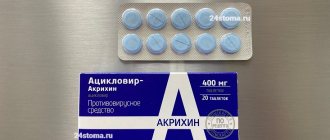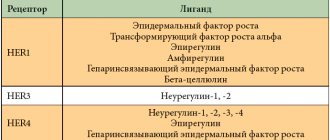Rezorba, 1 piece, 4 mg, lyophilisate for solution for infusion
IV
, drip, for at least 15 minutes.
For bone metastases and osteolytic lesions in multiple myeloma
The recommended dose is 4 mg every 3–4 weeks. Additionally, it is recommended to prescribe calcium orally at a dose of 500 mg/day and vitamin D at a dose of 400 IU/day.
For hypercalcemia (albumin-corrected calcium concentration ≥12 mg/dL or 3 mmol/L) caused by malignant tumors,
The recommended dose is 4 mg once. The infusion is carried out provided that the patient is adequately hydrated.
Patients with impaired renal function
Hypercalcemia due to malignant tumors.
The decision to treat patients with severe renal impairment with zoledronic acid should only be made after a careful assessment of the risk/benefit ratio. If the serum creatinine concentration is <400 µmol/l (<4.5 mg/dl), no dosage adjustment is required.
Bone metastases of common malignant tumors and myeloma.
The dose of zoledronic acid depends on the initial creatinine Cl level, calculated using the Cockcroft-Gault formula. In case of severe renal impairment (Cl creatinine <30 ml/min), the use of zoledronic acid is not recommended.
Recommended doses for mild to moderate renal impairment (Cl creatinine 30–60 ml/min) are given below.
| Initial Cl creatinine value, ml/min | Recommended dose of zoledronic acid, mg |
| >60 | 4 |
| 50–60 | 3,5 |
| 40–49 | 3,3 |
| 30–39 | 3 |
Determination of serum creatinine concentration should be carried out before each dose of the drug. If renal dysfunction is detected, the next administration of zoledronic acid should be postponed.
Renal dysfunction is determined by the following parameters:
- for patients with normal initial creatinine values (<1.4 mg/dl) - an increase in serum creatinine concentration by 0.5 mg/dl;
- for patients with deviations in the initial level of creatinine (>1.4 mg/dl) - an increase in the concentration of creatinine in the blood serum by 1 mg/dl.
Therapy with zoledronic acid is resumed only after the creatinine level reaches values exceeding the initial value by no more than 10%, at the same dose that was used before interruption of treatment.
Preparation of solution for infusion
Prepare the solution under aseptic conditions; Dissolve 4 mg in 5 ml of water for injection, shake gently until completely dissolved. Dilute the resulting solution with the required dose in 100 ml of 0.9% sodium chloride solution or 5% dextrose solution. Do not use solutions containing calcium. It is advisable to use the prepared solution immediately after preparation. Unused solution can be stored in the refrigerator at a temperature of 2–8 °C for no more than 24 hours. The solution stored in the refrigerator should be warmed to room temperature before administration.
Rezorba
Zoledronic acid is a highly effective bisphosphonate that selectively acts on bone tissue. The drug inhibits bone resorption by acting on osteoclasts. The selective effect of bisphosphonates on bone tissue is based on their high affinity for mineralized bone tissue. The exact molecular mechanism responsible for the inhibition of osteoclast activity still remains unclear.
Zoledronic acid does not have undesirable effects on bone formation, mineralization, or mechanical properties.
In addition to its inhibitory effect on bone resorption, zoledronic acid has antitumor properties that ensure the effectiveness of the drug against bone metastases. In vivo: inhibits bone resorption by osteoclasts, changes the microenvironment of the bone marrow, leads to a decrease in the growth of tumor cells; exhibits antiangiogenic activity. Suppression of bone resorption is clinically accompanied, among other things, by a pronounced decrease in pain.
In vitro: inhibits the proliferation of osteoblasts, exhibits direct cytostatic and proapoptotic activity, a synergistic cytostatic effect with antitumor drugs; anti-adhesive and anti-invasive activity. Zoledronic acid, due to its synergistic effect, in combination with hormonal therapy or chemotherapy, suppresses proliferation and induces apoptosis, has a direct antitumor effect against human myeloma cells and breast cancer, and also reduces the penetration of human breast cancer cells through the extracellular matrix, which indicates the presence of antimetastatic properties. In addition, zoledronic acid inhibits the proliferation of human and animal endothelial cells and has an antiangiogenic effect.
In patients with breast cancer, prostate cancer and other solid tumors with metastatic bone lesions, zoledronic acid prevents the development of pathological fractures, spinal cord compression, reduces the need for radiation therapy and surgical interventions, and reduces tumor hypercalcemia. The drug is able to inhibit the progression of pain. The therapeutic effect is less pronounced in patients with osteoblastic lesions than in patients with osteolytic lesions.
In patients with multiple myeloma and breast cancer with at least one bone lesion, the effectiveness of zoledronic acid at a dose of 4 mg is comparable to pamidronic acid at a dose of 90 mg.
In patients with tumor hypercalcemia, the effect of the drug is characterized by a decrease in the level of calcium in the blood serum and calcium excretion by the kidneys. The average time for calcium levels to normalize is about 4 days. By the 10th day, calcium concentration is normalized in 87-88% of patients. The average time to relapse (albumin-corrected serum calcium level of at least 2.9 mmol/L) is 30-40 days. There are no significant differences between the effectiveness of zoledronic acid at doses of 4 and 8 mg in the treatment of hypercalcemia.
Studies have shown no significant differences in the incidence or severity of adverse events observed in patients receiving zoledronic acid 4 mg, 8 mg, pamidronic acid 90 mg, or placebo for either bone metastases or hypercalcemia.
Content
- Characteristics of resorb (portable size 4 mg solution)
Contents: 1 fl.
contain: zoledronic acid monohydrate 4.
26 mg, which corresponds to the content of anhydrous zoledronic acid 4 mg. Excipients: D-mannitol - 220 mg, sodium citrate dihydrate - 27.
34 mg (in terms of sodium citrate anhydrous - 24 mg).
Solvent in ampoule: water for injection - 5 ml.
Solvent in container: sodium chloride solution for infusion 0.
9% - 100 ml.
Pharmacological Action: Zoledronic acid is a highly effective bisphosphonate that selectively acts on bone tissue.
The drug inhibits bone resorption by acting on osteoclasts.
The selective effect of bisphosphonates on bone tissue is based on their high affinity for mineralized bone tissue.
The exact molecular mechanism responsible for the inhibition of osteoclast activity still remains unclear.
Zoledronic acid does not have undesirable effects on bone formation, mineralization, or mechanical properties.
In addition to its inhibitory effect on bone resorption, zoledronic acid has antitumor properties that ensure the effectiveness of the drug against bone metastases.
In vivo: inhibits bone resorption by osteoclasts, changes the microenvironment of the bone marrow, leads to a decrease in the growth of tumor cells; exhibits antiangiogenic activity.
Suppression of bone resorption is clinically accompanied, incl.
h.
, a pronounced decrease in pain.
In vitro: inhibits the proliferation of osteoblasts, exhibits direct cytostatic and proapoptotic activity, a synergistic cytostatic effect with antitumor drugs; anti-adhesive and anti-invasive activity.
Zoledronic acid, due to its synergistic effect, in combination with hormonal therapy or chemotherapy, suppresses proliferation and induces apoptosis, has a direct antitumor effect against human myeloma cells and breast cancer, and also reduces the penetration of human breast cancer cells through the extracellular matrix, which indicates the presence of antimetastatic properties.
In addition, zoledronic acid inhibits the proliferation of human and animal endothelial cells and has an antiangiogenic effect.
In patients with breast cancer, prostate cancer and other solid tumors with metastatic bone lesions, zoledronic acid prevents the development of pathological fractures, spinal cord compression, reduces the need for radiation therapy and surgical interventions, and reduces tumor hypercalcemia.
The drug is able to inhibit the progression of pain.
The therapeutic effect is less pronounced in patients with osteoblastic lesions than in patients with osteolytic lesions.
In patients with multiple myeloma and breast cancer with at least one bone lesion, the effectiveness of zoledronic acid at a dose of 4 mg is comparable to pamidronic acid at a dose of 90 mg.
In patients with tumor hypercalcemia, the effect of the drug is characterized by a decrease in the level of calcium in the blood serum and calcium excretion by the kidneys.
The average time for calcium levels to normalize is about 4 days.
By the 10th day, calcium concentration is normalized in 87-88% of patients.
Mean time to relapse (albumin-corrected serum calcium level of at least 2.
9 mmol/l) is 30-40 days.
There are no significant differences between the effectiveness of zoledronic acid at doses of 4 and 8 mg in the treatment of hypercalcemia.
Studies have shown no significant differences in the incidence or severity of adverse events observed in patients receiving zoledronic acid 4 mg, 8 mg, pamidronic acid 90 mg, or placebo for either bone metastases or hypercalcemia.
Indications for Use: - hypercalcemia (albumin-corrected serum calcium concentration 12 mg/dL or 3 mmol/L) induced by malignant tumors; - metastatic bone lesions in malignant solid tumors and multiple myeloma (to reduce the risk of pathological fractures, spinal cord compression , tumor-related hypercalcemia, and decreased need for radiation therapy).
Directions for Use: IV drip for at least 15 minutes.
For bone metastases and osteolytic lesions in multiple myeloma, the recommended dose is 4 mg every 3-4 weeks.
Additionally, it is recommended to prescribe oral calcium at a dose of 500 mg/day and vitamin D at a dose of 400 IU/day.
For hypercalcemia (albumin-corrected calcium concentration ≥12 mg/dL or 3 mmol/L) caused by malignant tumors, the recommended dose is 4 mg, once.
The infusion is carried out provided that the patient is adequately hydrated.
Patients with impaired renal function.
Hypercalcemia due to malignancy: The decision to treat patients with severe renal impairment with zoledronic acid should only be made after a careful assessment of the risk/benefit ratio.
At serum creatinine concentration
5 mg/dL dosage adjustment is not required.
Bone metastases of common malignant tumors and multiple myeloma: the dose of zoledronic acid depends on the initial CK level calculated using the Cockroft-Gault formula.
In case of severe renal impairment (KR
Recommended doses for mild or moderate renal impairment (creatinine clearance values 30-60 ml/min) are given below.
Initial CC value (ml/min) Recommended dose of zoledronic acid>60 4.
0 mg50-60 3.
5 mg40-49 3.
3 mg30-39 3.
0 mg Serum creatinine concentration should be determined before each dose of the drug.
If renal dysfunction is detected, the next administration of zoledronic acid should be postponed.
Renal dysfunction is determined by the following parameters: - for patients with normal initial creatinine values (1.
4 mg/dL) – an increase in serum creatinine concentration by 1 mg/dL.
Therapy with zoledronic acid is resumed only after the creatinine level reaches values exceeding the initial value by no more than 10%, at the same dose that was used before interruption of treatment.
Instructions for preparing solution for infusion.
The solution is prepared under aseptic conditions; 4 mg is dissolved in 5 ml of water for injection, shake gently until completely dissolved.
The resulting solution with the required dose is diluted in 100 ml 0.
9% sodium chloride solution or 5% dextrose solution.
Do not use solutions containing calcium.
It is advisable to use the prepared solution immediately after preparation.
Unused solution can be stored in the refrigerator at a temperature of +2° to + 8°C for no more than 24 hours.
The solution, stored in the refrigerator, should be warmed to room temperature before administration.
Interaction: Solutions containing calcium, in particular Ringer's solution, should not be used as solvents.
When used simultaneously with antitumor drugs, diuretics, antibiotics, analgesics, no clinically significant interaction was observed.
Bisphosphonates and aminoglycosides have a unidirectional effect on the concentration of calcium in the blood serum, therefore, when administered simultaneously, the risk of developing hypocalcemia and hypomagnesemia increases.
If hypocalcemia, hypophosphatemia or hypomagnesemia develops, short-term additional administration of the corresponding substances may be necessary.
Patients with untreated hypercalcemia usually have impaired renal function, so careful monitoring of renal function in this category of patients is necessary.
When deciding whether to treat patients with bone metastases with zoledronic acid, it should be taken into account that the therapeutic effect occurs 2-3 months after the start of treatment with zoledronic acid.
Caution is necessary when using zoledronic acid concomitantly with drugs that have a potential nephrotoxic effect.
In patients with multiple myeloma, the risk of developing renal dysfunction may be increased when bisphosphonates are administered intravenously in combination with thalidomide.
Although the risk of the above-described complications is reduced when zoledronic acid is administered at a dose of 4 mg over at least 15 minutes, the possibility of renal dysfunction remains.
There have been cases of deterioration in renal function, progression of renal failure and the need for hemodialysis with the first or single use of zoledronic acid.
The drug should not be mixed with other drugs.
Side Effects: Adverse reactions are listed below by organs and systems, indicating the frequency of their occurrence.
Frequency criteria: very often (?1/10), often (?1/100,


